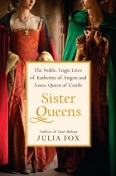BKMT READING GUIDES
Sister Queens: The Noble, Tragic Lives of Katherine of Aragon and Juana, Queen of Castile
by Julia Fox
Hardcover : 480 pages
0 club reading this now
0 members have read this book
Introduction
The history books have cast Katherine of Aragon, the first queen of King Henry VIII of England, as the ultimate symbol of the Betrayed Woman, cruelly tossed aside in favor of her husband's seductive mistress, Anne Boleyn. Katherine's sister, Juana of Castile, wife of Philip of Burgundy and mother of the Holy Roman Emperor Charles V, is portrayed as ?Juana the Mad,? whose erratic behavior included keeping her beloved late husband's coffin beside her for years. But historian Julia Fox, whose previous work painted an unprecedented portrait of Jane Boleyn, Anne's sister, offers deeper insight in this first dual biography of Katherine and Juana, the daughters of Spain's Ferdinand and Isabella, whose family ties remained strong despite their separation. Looking through the lens of their Spanish origins, Fox reveals these queens as flesh-and-blood women?equipped with character, intelligence, and conviction?who are worthy historical figures in their own right.
When they were young, Juana's and Katherine's futures appeared promising. They had secured politically advantageous marriages, but their dreams of love and power quickly dissolved, and the unions for which they?d spent their whole lives preparing were fraught with duplicity and betrayal. Juana, the elder sister, unexpectedly became Spain's sovereign, but her authority was continually usurped, first by her husband and later by her son. Katherine, a young widow after the death of Prince Arthur of Wales, soon remarried his doting brother Henry and later became a key figure in a drama that altered England's religious landscape.
Ousted from the positions of power and influence they had been groomed for and separated from their children, Katherine and Juana each turned to their rich and abiding faith and deep personal belief in their family's dynastic legacy to cope with their enduring hardships. Sister Queens is a gripping tale of love, duty, and sacrifice?a remarkable reflection on the conflict between ambition and loyalty during an age when the greatest sin, it seems, was to have been born a woman.
Julia Fox On Sister Queens
Julia Fox is an author and historical researcher. She lives in London with her husband, the Tudor historian, John Guy. Her first book was Jane Boleyn: The Infamous Lady Rochford, a study of the lady-in-waiting at the court of Henry VIII of England and the sister-in-law of Anne Boleyn.

This book evolved naturally from my last. Then, challenging the legends surrounding the life of Jane Boleyn, brought me face to face with the Boleyns' arch-enemy, Katherine of Aragon, herself also a woman of myth. Endowed with almost saint-like qualities by her admirers, both in her own time and in ours, she is often seen as an icon of perfection as a wife, a mother and as a queen, someone too good to be true. Yet, behind all this hype and spin which turns her into a cardboard caricature, there is a real person struggling to emerge. She's the woman I set out to find; or at least, she's one of them!
For when I began to explore Katherine's Spanish background, her sister Juana entered the picture, another figure of legend, a queen still known in her homeland as 'Juana the Mad.' When I found I couldn't get her out of my mind, the idea of bringing the sisters--whose lives were once so intertwined --back together again took root.
A pivotal moment in my research was when I visited Granada. If one single episode influenced Katherine and Juana, it's the fall of the Moors' final bastion on the Spanish mainland, an event that was so momentous in its own time, it ranks with the D-Day landings and the end of the Second World War in ours. As young, impressionable girls, Katherine and Juana were present when, after years of bloodshed and suffering, the last Moorish king rode down the steep track leading from his great palace complex of the Alhambra to surrender the keys of his city to the sisters' parents, Ferdinand and Isabella. The girls were left in no doubt that they must fight for what they believed to be right, no matter what the personal cost.
Even today, the Alhambra is magical. We can climb the paths into the intimate, intricately-carved rooms of the Moors' magnificent palace where the sisters would once have sat, wander through shady gardens, peer into subterranean dungeons which once held manacled captives; we can gaze up at the tower where the Christians raised their banners (amazingly, still preserved) to signal the triumph of their faith. We can go to the Royal Chapel in the city where Juana lies with her husband and her parents, each in narrow iron coffins, in a small, dimly-lit vault beneath the imposing mausoleums above. To see all this is to enter Katherine and Juana's world, and yearn to discover more.
And the archival sources remain. Letters, contemporary records and first-hand accounts survive in abundance, allowing the sisters to speak to us with their own voices across the centuries. It was in that evidence that I immersed myself over the three years it took to research and write this book. I tried to approach it with a fresh eye, re-evaluating everything and sweeping away the cobwebs, aiming to portray these women, warts and all, as the flesh and blood figures they once were. I owe them that.
Discussion Questions
No discussion questions at this time.Book Club Recommendations
Recommended to book clubs by 0 of 0 members.
Book Club HQ to over 90,000+ book clubs and ready to welcome yours.
Get free weekly updates on top club picks, book giveaways, author events and more








